I’d procrastinated on reading this article, mainly due to its length, but it’s a fascinating read and entertainingly written – well worth the investment in time. While it eventually settles down into an examination of the German immigrant population and its effect on the border state, it’s introduced by a look at the city that Sherman and Grant called home, and by this rather fabulous summary:
The leading city in one of the nation’s most populous slaveholding states, St. Louis was a strategic prize like no other. Not only the largest settlement beyond the Appalachians, it was also the country’s second-largest port, commanding the Mississippi River as well as the Missouri, which was then navigable as far upstream as what is now the state of Montana. It was the eastern gateway to the overland trails to California. Last but far from least, the city was home to the St. Louis Arsenal, the biggest cache of federal arms in the slave states, a central munitions depot for Army posts between New Orleans and the Rockies. Whoever held St. Louis held the key to the Mississippi Valley and perhaps even to the whole American West.
The city and its surrounding state stood at a crossroads between the cultures of the North and the South, between slavery and freedom, between an older America and a new one. The old Missouri flourished in the region known as Little Dixie, the rich alluvial lands where black field hands toiled in the hemp and cotton fields. The new one could be found in St. Louis, where block after block of red-brick monotony— warehouses, manufacturing plants, and office buildings—stretched for miles along the bluffs above the river. Each year, more than 4,000 steamboats shouldered up to the wharves, vessels with names like War Eagle, Champion, Belle of Memphis, and Big St. Louis. The smoke from their coal-fired furnaces mingled with the thick black clouds belching from factory smokestacks, so that on windless days the sun shone feebly through a dark canopy overhead.
(Hands up if you knew that “second largest port” fact. My hand is decidedly lowered!)

